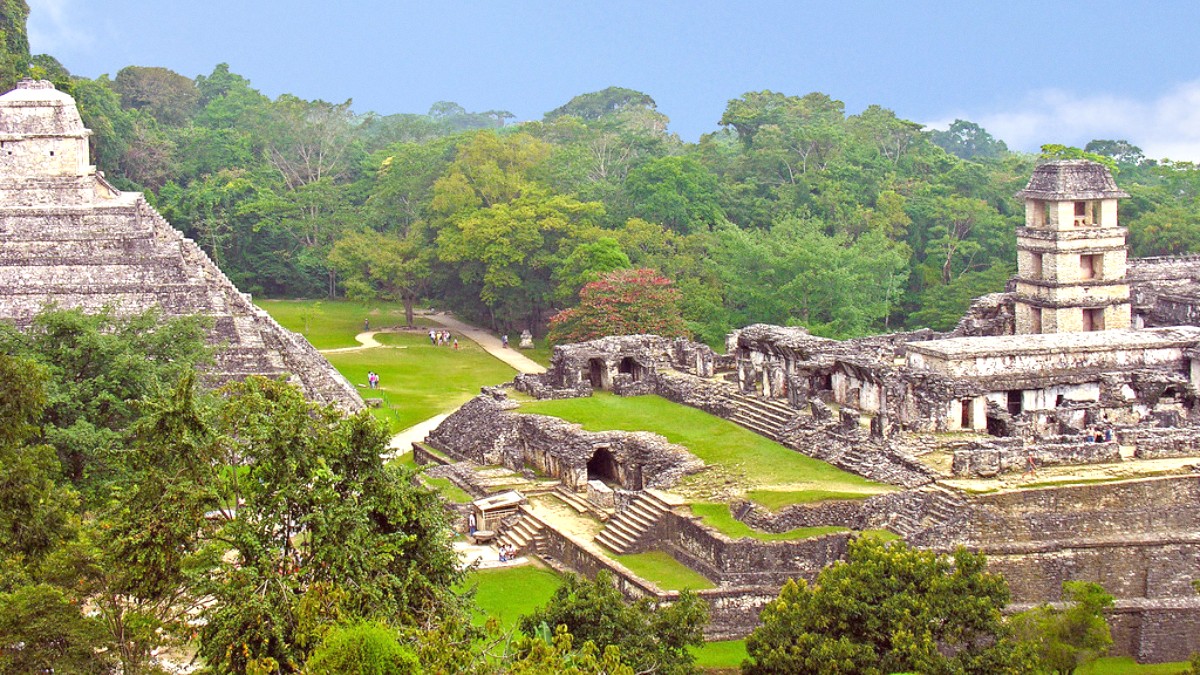
Tabasco And Chiapas, Mexico
The Palenque Archaeological Site is the undisputed centerpiece of any visit. Its historical significance and stunning beauty make it a required stop.
The site features sophisticated architecture, detailed stucco reliefs, and intricate hieroglyphic inscriptions. It offers deep insights into Maya cosmology, political structures, and artistic achievements. Palenque’s architecture feels graceful and refined, showing harmony with its jungle setting.
Hiring a licensed guide at the entrance brings the ancient city to life, explaining hieroglyphs and historical context.
Located conveniently within the archaeological zone, near the main entrance/exit. A visit before or after exploring the ruins greatly deepens your understanding.
Full-scale replica of Pakal the Great's sarcophagus lid; exquisite jade masks and ornaments; ceramics and fragments of stucco carvings.
Informative panels (Spanish and English) explain Maya history, cosmology, writing, and discoveries. Entrance is typically included with your archaeological site ticket.
Check the INAH website (inah.gob.mx) for current operating hours.
The museum helps visualize the lives of the ancient Maya and the significance of artifacts found within the temples you explore.
While the Palenque archaeological site is the main historical landmark, its broader Maya world context enriches your experience.
Thousands of unexcavated mounds and structures lie hidden beneath dense jungle canopy within the national park.
Their presence underscores the immense size and complexity of the ancient city. The site museum helps visualize this broader urban sprawl.
Smaller Maya sites like Moral Reforma or Pomoná exist, requiring specialized tours for access.
A modern town, serving as a base for visitors to the ruins rather than a historical destination in itself.
Architecture reflects contemporary Mexican small-town design, with a central plaza, local shops, and eateries.
The historical significance concentrates almost entirely on the ancient Maya city and its surrounding jungle.
Consider booking your tours to attractions and sightseeing spots in advance via GetYourGuide for convenience.
The water color at Agua Azul waterfalls appears best during the dry season. Heavy rains can make the water muddy and less blue.
Observe wildlife from a distance and never feed animals. Early morning or late afternoon visits offer best chances for sightings.
Palenque's natural surroundings present a refreshing contrast to the ancient ruins, with stunning waterfalls and wildlife viewing opportunities.
Misol-Ha is a powerful single waterfall, cascading approximately 35 meters (115 feet) into a wide, circular pool below. The water's force creates a misty spray that cools the air.
Agua Azul translates to "Blue Water," and these waterfalls live up to their name. They comprise a spectacular series of turquoise-blue cascades and natural pools formed by the Xanil River.
Roberto Barrios offers a more tranquil and less-visited experience compared to Agua Azul. It features a series of multi-tiered waterfalls and natural pools, an idyllic setting for swimming and exploration.
The dense jungle surrounding Palenque, within the National Park (which includes the archaeological site), teems with wildlife.
You can secure attraction tickets and guided tours via online platforms.
For example, GetYourGuide simplifies the process of finding and booking activities for your trip.
Book attraction tickets and tours in advance, especially during high season, to secure your preferred options.
Utilize platforms like GetYourGuide for convenient booking and a variety of options.
Hiring a licensed guide at the Palenque ruins is beneficial; their knowledge brings the ancient city to life.
The tropical sun can be intense. Protect your skin and head from prolonged exposure.
Shop SunscreenMosquitoes and other insects are common in jungle areas, especially near water.
Shop RepellentHigh humidity and activity levels necessitate constant water intake to avoid dehydration.
Shop Water BottlesYou will navigate uneven paths and climb many steps at the archaeological site and waterfalls.
Entrance fees for the ruins and waterfalls often require cash payments.
The Palenque Site Museum greatly deepens your site understanding. Its collection of artifacts discovered at Palenque adds context to the ancient city.
Beyond the main excavated area, thousands of unexcavated mounds lie hidden, underscoring the ancient city's immense size and complexity.
A visit to the Palenque Site Museum, either before or after exploring the ruins, greatly deepens your site understanding.
It helps visualize the lives of the ancient Maya and the significance of the artifacts found within the very temples you just walked through.
Beyond the main attractions, Palenque is a few hidden gems offering unique experiences and a different perspective.
This is a conservation and rehabilitation center dedicated to rescuing and protecting local wildlife. It acts as a sanctuary for injured, trafficked, or displaced animals.
A local river near several eco-lodges on the Carretera Ruinas. It features natural swimming spots popular with locals.
A Maya archaeological site that requires more effort to reach but provides a sense of untouched history.
Consider this for a dive into regional archaeology beyond the main Palenque site.
Another Maya site in the wider Chiapas region, also offering a more secluded archaeological experience.
Specialized tours or self-guided adventure are typically needed to visit Pomoná.
The wider region includes thousands of unexcavated mounds and structures hidden beneath the dense jungle canopy.
The site museum aids in visualizing this broader urban sprawl and the scale of Maya civilization.
The Palenque Archaeological Site is the central attraction, offering deep insights into Maya civilization.
Misol-Ha, Agua Azul, and Roberto Barrios waterfalls provide stunning natural beauty and opportunities for swimming.
Visit Aluxes Ecoparque for ethical wildlife viewing and support for conservation efforts.